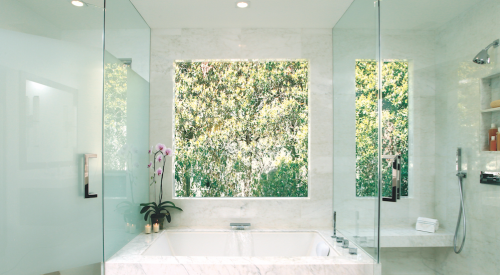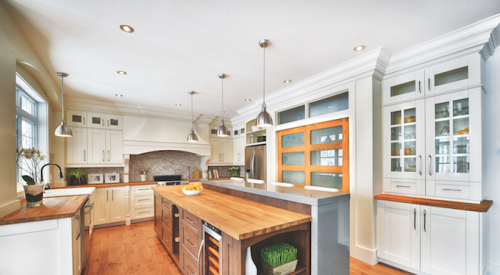|
 Many homes offices are used by more than one person. This office's centralized work area accommodates at least two people. |
What's driving the trend? Integration of computers in every aspect of daily life, from family budgeting to e-mail to personal Web sites; telecommuters who want to avoid energy-sapping commutes that eat up family time; and work-at-home business owners who have dropped out of the corporate life. "We are designing more home offices that are truly used for business," Pam Di Valerio, owner and designer at Di Valerio Interiors Kitchen and Bath Design in Santa Clarita, Calif., says.
Placement MattersAs our lifestyles have changed, offices have become essential elements in homes. West Hartford, Conn., architect Neal Zimmerman says, "Builders need to provide for it in the same way they provide for the kitchen and bath."
As with kitchens and baths, the office location needs to be versatile and meet the buyer's needs. There are some basic considerations, though. For example: privacy. "It wouldn't be a great idea to have a home office next to a kitchen because of the noise," says Zimmerman of Neal Zimmerman & Associates AIA. "It's not a good idea to have an office in an alcove that opens into a family space either."
So, where do you place the office? "It's good if it could be near or off a front entry," Zimmerman says, "Or, if it could have its own front entry."
"It's that question of privacy versus availability from your family," Malouf says. Montalbano Homes tends to place the room in the heart of the home or near the master bedroom.
"With dual-income families and work-at-home moms, they want that ability to still connect with the family," Malouf says. An office at the center of activity provides that opportunity but creates issues with noise and privacy.
An office near the master bedroom solves the noise issue. "We've created office options in the adjoining bedroom off the master bedrooms," Malouf says. "In many cases, it's just converting a second bedroom into an office/den situation we call libraries."
Must-Have FeaturesEvery home office must be equipped with necessities. Today, that means technology. "The home office is usually a digital communication center," Zimmerman says. Obviously, offices should have an Internet connection, whether through a phone jack or via cable/satellite. In addition, the equipment location should include proper ventilation.
"Technology is driving the furniture," Lisa Kanarek, founder of Dallas-based HomeOfficeLife.com, says. "It's driving how the furniture is designed and how it's used."
Builders now offer built-in cabinetry options during the selection process so home buyers can plan for a complete office. One of the biggest considerations is storage because home offices often lack storage space, Kanarek notes.
"There will always be a need for ample storage behind doors, including rollout shelving to hide fax machines, printers and copiers," Di Valerio says. "Also, plenty of bookshelves, file drawers and counter/work surface are a must.
"Because computers are the main staple in any home office, I always design a dual work area," Di Valerio says. "One area being for computer and keyboard, the other being a writing surface."
Builders have discovered the importance of lighting in offices. "Proper lighting, including general, task and display lighting can not be an afterthought," Di Valerio says.
Montalbano Homes adds natural light while adding a touch of design element. "We like to do the entry with glass doors," Malouf says. "We try to make it have a good feel but elegant so it still feels homey."
|












